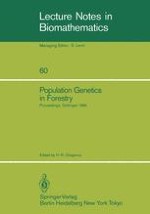1985 | OriginalPaper | Buchkapitel
Evolution of Outbreeding Systems
verfasst von : M. D. Ross
Erschienen in: Population Genetics in Forestry
Verlag: Springer Berlin Heidelberg
Enthalten in: Professional Book Archive
Aktivieren Sie unsere intelligente Suche, um passende Fachinhalte oder Patente zu finden.
Wählen Sie Textabschnitte aus um mit Künstlicher Intelligenz passenden Patente zu finden. powered by
Markieren Sie Textabschnitte, um KI-gestützt weitere passende Inhalte zu finden. powered by
This paper gives a personal view of the evolution of outbreedlng systems, emphasizing the many features that hermaphrodite and monoecious populations, especially the more outbred ones, have in common with sex-polymorphic populations. Such features include frequency-dependency for fitness, functional sex, and combined gamete selfing rate. This last selfing rate differs from that for the ovules, since the pollen selfing rate differs from the ovule rate and is frequency dependent, because of variation in ovule and pollen fertilities. Five topics are emphasized. These are: (1) the concept of successful gametes, defined as gametes (of both sexes) that take part in fertilization; (2) sexual asymmetry, defined as non-constant pollen to ovule ratios among individuals (or genotypes or phenotypes); (3) allocation of resources to male or female reproduction, where such allocation may differ among individuals; (4) individual selection; and (5) genetic control. The concept of successful gametes is used to define fitness (the total number of successful gametes per individual), functional sex (the number of successful ovules as a proportion of all successful gametes, or fitness value), and combined gamete selfing rate (the number of ovules and pollen grains of an individual that take part in selfing, as a proportion of all successful gametes of that individual). Sexual asymmetry is he-Id to be of fundamental importance not only for sex-polymorphic, but also for the more outbred hermaphrodite populations, and evidence for asymmetry is presented for hermaphrodite and monoecious populations. Asymmetry is responsible for maintenance of polymorphisms, and also for frequency-dependent selection, differential ovule and pollen outcrossing rates, and variation in extents of male and female functioning, so that these last three characters are common to asymmetric hermaphrodite and to sex-polymorphic populations. A simple model of male/female resource allocation ensures that any variation in such allocation results in asymmetry with frequency-dependent selection. Numerical examples show that intermediate or incompletely dominant gene action for resource allocation may result in overdominance or in equal genotypìc fitnesses in equilibrium populations, for hermaphrodite, gynodioecious, or subdioecious populations. There is a continuum among these population types. It is held that individual selection is sufficient to bring about the evolution of sex polymorphisms, and such evolution is not always accompanied by the evolution of outcrossing. The importance of the mode of genetic control of a sex phenotype is emphasized, since differences in such control may entirely determine whether a polymorphism can be maintained or not.
